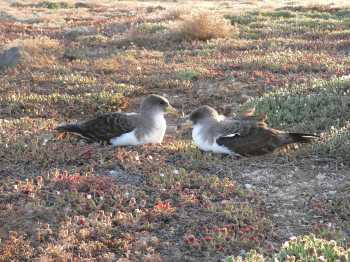Sandra Hervías (Portuguese Society for the Study of Birds [SPEA], Lisbon, Portugal) and colleagues have published on effects of alien mammals on breeding by Cory's Shearwaters Calonectris diomedea in the journal Biological Invasions.
The paper's abstract follows:
"The most common invasive mammals-mice, rats, and cats-have been introduced to islands around the world, where they continue to negatively affect native biodiversity. The eradication of those invasive mammals has had positive effects on many species of seabirds. However, the removal of one invasive mammal species may result in abundance changes of other species due to trophic and competitive interactions among species. Understanding the overall impact of several invasive species is a key challenge when evaluating the possible effects of eradication programmes. Here we assess the influence of the three most common invasive mammals on nest survival of Cory's shearwater (Calonectris diomedea). We monitored six breeding colonies over 3 years and measured the activity of mice, rats and cats to examine the influence of invasive mammals on nest survival. We found that nest survival showed a similar temporal trend in all years, with lowest weekly survival probabilities shortly after chicks hatched. Cats were identified as major predators of chicks, but no measure of colony-specific cat activity was able to adequately explain variation in shearwater nest survival. Nest survival was on average 0.38 (95 % confidence interval 0.20-0.53) and varied among colonies as well as over time. We found a small positive influence of rats on nest survival, which may indicate that the presence of small rodents as alternative prey may reduce cat predation of chicks. Our findings suggest that the eradication of rodents alone may exacerbate the adverse effects of cats on shearwater nest survival."

A Cory's Shearwater pair at its breeding site
Photograph by Paulo Catry
Reference:
Hervías, S., Henriques, A., Oliveira, N., Pipa, T., Cowen, H., Ramos, J.A., Nogales, M., Geraldes, P., Silva, C., Ruiz de Ybáñez et al. 2012. Studying the effects of multiple invasive mammals on Cory's Shearwater nest survival. Biological Invasions DOI: 10.1007/s10530-012-0274-1.
John Cooper, ACAP Information Officer, 24 September 2012

 English
English  Français
Français  Español
Español